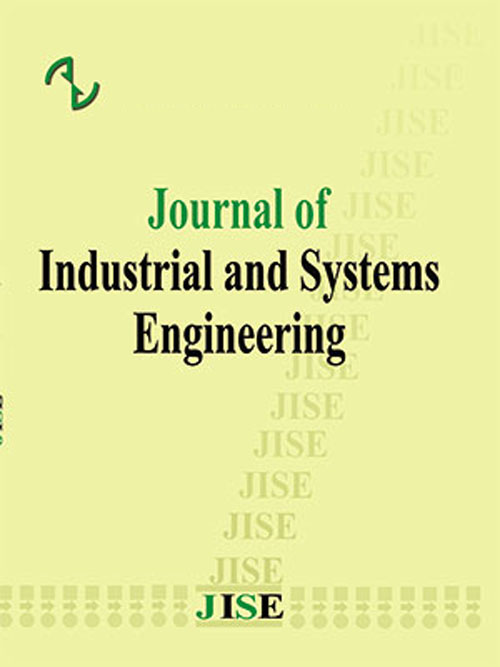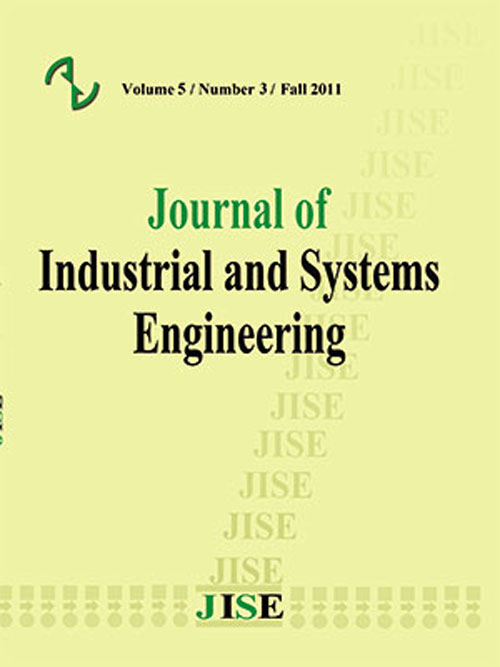فهرست مطالب

Journal of Industrial and Systems Engineering
Volume:7 Issue: 1, Autumn 2014
- تاریخ انتشار: 1393/09/13
- تعداد عناوین: 7
-
-
Pages 1-20The economical determination of lot size with capacity constraints is a frequently complex, problem in the real world. In this paper, a multi-level problem of lotsizing with capacity constraints in a finite planning horizon is investigated. A combination of ant colony algorithm and a heuristic method called shifting technique is proposed for solving the problem. The parameters, including the costs, demands and capacity of resources vary during the time. The goal is to determine the economical lot size value of each product in each period, so that besides fulfilling all the needs of customers, the total cost of the system is minimized. To evaluate the performance of the proposed algorithm, an example is used and the results are compared other algorithms such as: Tabu search (TS), simulated annealing (SA), and genetic algorithm (GA). The results are also compared with the exact solution obtained from the Lagrangian relaxation method. The computational results indicate that the efficiency of the proposed method in comparison to other meta-heuristics.Keywords: Production planning, Capacitated lot, sizing, Ant colony algorithm, Shifting technique
-
Pages 21-42This paper studies the economic-order-quantity model (EOQ) for deteriorating items in two cases (with and without shortages) to evaluate how vendor managed inventory (VMI) affects supply chain. We consider two-level supply chain (single supplier and a single retailer) with one instantaneous deteriorating item. A numerical example and sensitivity analysis are provided to illustrate the effect of related parameters on total cost and optimal order quantity of two systems. The results show that VMI works better and delivers lower cost in all conditions than traditional supply chain (the system before implementation of VMI).Keywords: Vendor, managed inventory, Supply chain, Economic order quantity model (EOQ), Deterioration
-
Pages 43-55This paper addresses to the Cell Formation Problem (CFP) in which Automated Guided Vehicles (AGVs) have been employed to transfer the jobs which may need to visit one or more cells. Because of added constraints to problem such as AGVs’ conflict and excessive cessation on one place, it is possible that AGVs select the different paths from one cell to another over the time. This means that the times and costs between cells are dynamic. The proposed model consists of 2 stages that stage (1) is related to a basic CFP, with a set of machine cells and their corresponding job families, while stage (2) is related to finding AGVs’ routing, to determine the dynamic costs. For solving this problem, a two-stage heuristic algorithm based on an exact method has been proposed. A computational experiment has been solved to show efficiency of proposed heuristic.Keywords: Cell formation problem, Routing problem, Automated guided vehicle, Twostage model, Two, stage heuristic
-
Pages 56-79In many industries such as automotive industry, there are a lot of suppliers dealing with the final products manufacturer. With growing numbers of suppliers, the suppliers’ efficiency measurement often becomes the most significant concern for manufacturers. Therefore, various performance measurement models such as DEA, AHP, TOPSIS, are developed to support supplier selection decisions. After an exhaustive review of the supplier selection methods, we employ data envelopment analysis (DEA) for computing the relative efficiency of the suppliers and introducing the most efficient supplier as a benchmark. In reality, there are large amounts of uncertainty regarding the suppliers’ measurements; therefore, we propose the robust optimization approach to the real application of DEA (RDEA). In this approach, uncertainties about incomes and outcomes of decision making units (DMUs) are involved in the relative suppliers’ efficiencies. The proposed RDEA approach is utilized for the selection of suppliers\ which manufacture the automotive safety components in Supplying Automotive Parts Company (SAPCO), an Iranian leading automotive enterprise. Numerical example will illustrate how our proposed approach can be used in the real supplier selection problem when considerable uncertainty exists regarding the suppliers’ input and output data.Keywords: Robust optimization, Supplier selection, Data envelopment analysis, Supply chain management
-
Pages 80-103These day, supply chains (SCs) have become more and more complicated and have extensively expanded and due to these complexities, the supply chain management (SCM) has encountered several uncertainties, and, as a result, trust and assurance between members in SCs has become essential for a successful SCM. Although trust is an inevitable component in nearly all fields in SCs, like cooperation, coordination and management. As Trust increases the sense of security among members and cuts back on the losses, this research attempts to introduce a mathematical model that is able to utilize trust as a main element in a two-echelon SC. Defining trust is difficult since it is analyzed from different perspectives, and it is used in a wide range of situations. Therefore, the aim of this study is to propose an appropriate definition for this concept according to SCs, and to present a two-echelon SC, including a retailer and a supplier. The supplier and the retailer play Stackelberg game in newsvendor framework. The order quantity and stock, as the best sections for proposing the definition of trust, is developed for retailer and supplier. In addition, Beta model is presented for calculating trust and finally in order to verify the quality and efficiency of the proposed model, a numerical example is also offered.Keywords: Newsvendor problem, Computational Trust model, Stackelberg game, Trust, Supply chain
-
Pages 104-117In this paper we study the topology effects on diffusion process in signed networks. Considering a simple threshold model for diffusion process, it is extended to signed networks and some appropriate definitions are proposed. This model is a basic model that could be extended and applied in analyzing dynamics of many real phenomena such as opinion forming or innovation diffusion in social networks. Studying the model declares that highly balanced dense clusters act as obstacles to diffusion process. This fact is verified by numerical simulations and it is declared that balanced dense clusters limit perturbation diffusion and the rest time. In other words the systems with more compatible communities and balanced clusters act more robust against perturbations. Moreover, the final state majority would be the same of more balanced cluster initially. These structural properties could be useful in analyzing and controlling diffusion process in systems.Keywords: Social networks, Innovation diffusion, Balanced clusters, Signed network
-
Pages 118-128Control charts are standard statistical process control (SPC) tools for detecting assignable causes. These charts trigger a signal when a process gets out of control but they do not indicate when the process change has begun. Identifying the real time of the change in the process, called the change point, is very important for eliminating the source(s) of the change. Knowing when a process has begun to change simplifies the identification of the special cause and consequently saves time and expenditure. This study uses genetic algorithms (GA) with optimum search features for approximately optimizing the likelihood function of the processfraction nonconforming. Extensive simulation results show that the proposed estimator outperforms the Maximum Likelihood Estimator (MLE) designed for step change regarding to speed and variance.Keywords: Quality control, Statistical process control, Change point, Genetic algorithm, np chart


